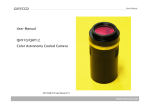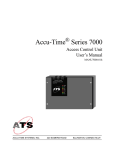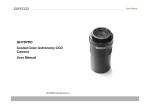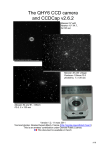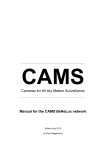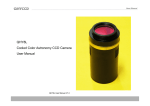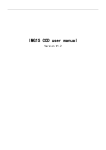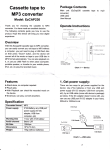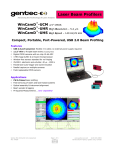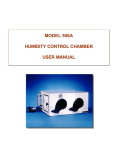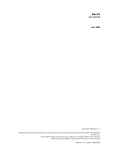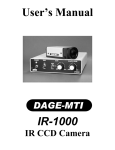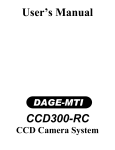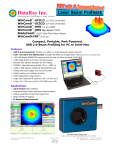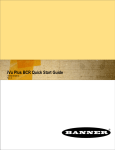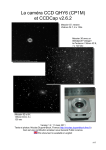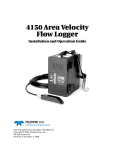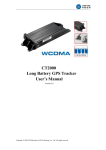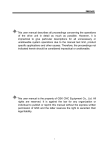Download QHY9 User Manual
Transcript
QHY-9 Mono Cooled astronomical CCD Camera User’s guide QHY-9 Users guide Ver 1.0 Contents: i) 1) 2) 3) 4) 5) 6) 7) 8) 9) 10) 11) Introduction ………………………………………………….……Page 3 Camera Interface connections…………………………………………Page 3 Accessories…………………………………………………………….Page 5 Driver Installation……………………………………………………...Page 8 Cable connection sequence…………………………………………….Page 8 DC 201 input voltage requirement…………………………...………..Page 8 How to avoid moisture in high humidity………………………………Page 9 Connection with QHY Filter wheel…………………………………....Page 9 Software Operation Guide……………………………………………..Page 10 Camera disassembly and CCD cleaning……………………………….Page 11 Camera Specifications………………………………………………….Page 13 QHY-9 Drawings……………………………………………………….Page 14 i) QHY9 CCD Camera User Manual Thank you for purchasing a QHY product. Please take the time to read the user’s guide so you can familiarize yourself with the camera and its functions so you can get the most out of your new purchase. 1) Camera Interface connections 1) Filter wheel interface socket (For optional QHY filter wheel) 2) USB connector (Use USB 2.0 Cables only. If over 3 Meters in length please use a USB Hub) 3) 9-PIN connector for external power supply via QHYCCD supplied 9-pin cable and DC201 4) M42/0.75 thread mount, 3mm Depth Standard Telescope thread. When using a T ring not supplied by QHYCCD, please check if its thread depth exceeds 3mm, as it may protrude inside the camera and damage the shutter when longer than 3mm. 5) 6) 7) 8) Color wheel communication LED. (Flash’s when communicating with host) Status indication LED. (On when camera is idle) Air socket port. M5 Europe standard (Used for Gas purging) Air socket port. M5 Europe standard (Used for Gas purging) 2) Accessories 1) M42 (male) to M54 (male) adapter Mounts camera to optional filter wheel 2) Optional M42 (male) to M42 (female) optic window (AR+AR or IR+AR) Helps avoid the CCD chamber sealing glass from condensation when humidity is RH>65% 3) Special 9-pin power cable, 2.5 meter length 4) Filter wheel communication cable (Included with filter wheel) 5) Optional desiccators, in high humidity environments, it is used to dry the camera internally. It must be used in conjunction with Air socket option 6 below. 6) Optional Air sockets, used for connecting a dry air recycle system. 7) USB 2.0 cable 1.5meter 8) DC201 Power supply adapter/TEC controller 9) Optional 12V 4A AC power supply adapter. Input voltage range 100-240V. 10) Optional Air sealed box with electrically heated silicon gel. 3) Driver Installation 1) Run the “install.bat” found in the driver folder. The driver files will then be copied into the C:\WINDOWS\INF and the C:\WINDOWS\SYSTEM32\DRIVERS directories. If your windows installation is not in C:\WINDOWS, then the “install.bat” file should be modified with the correct windows location. 2) Or you may install the files manually by: 1. Copying all *.inf file into WINDOWS/INF folder 2. Copying all *.sys file into WINDOWS/SYSTEM32/DRIVERS folder 3) Connect the USB cable from camera to computer only. You do not need the 9-pin power supply cable connected. The computer will respond with “New hardware found”. Follow the steps shown on the screen to complete the installation. 4) Cable connection sequence To help protect the camera from power surges or electrical spikes, we recommend the following sequence: 1) USB cable first, 9pin power cable second, 12V supply last. Or: 2) 9pin cable first, 12V supply, USB cable last. Try and avoid the following methods of connection: 1) Anytime when the DC102 is powered (12V supply), avoid “Hot plugging” of the 9pin cable. 2) Connecting the USB cable while 9pin cable is connected without 12V supply on, computer may not find the camera. Orientation of the 9pin cable: The 9pin cable has one end with a EMC ring. This end should be connected closest to the DC102. 5) DC201 Input voltage requirement DC201 requires a regulated 12V input . When using an external battery, it may exceed 13V. The high voltage may reduce the life of TEC (Thermal Electric Cooler). If forced to use an external battery, then please avoid using Maximum cooling settings. A good setting would be at 75% to 80% cooling power. 6) How to avoid moisture in high humidity Factory default, the QHY9 only has only one optical window (The glass sealing the CCD chamber). The QHY9 has an excellent 2 stage TEC which will obtain -50 deg C below ambient. Although the CCD sensor is located in an airproof chamber, in a high humidity environments where RH>65%, the front side of the CCD sealing chamber glass may attract moisture. Although unavoidable due to nature, it can be prevented by: Method 1: Reducing the TEC power, and avoiding the dew point. Method 2: Use of dual optical windows by fitting a second optical window (see Section 2, sub 2), to the CCD camera. This to make the whole ccd camera contain its own air and avoid external cooler air from dewing on the glass. The use of the Air sockets at the same time will help where humidity is very high. Note: Use of extra glass will cause a slight loss in optical transmission and may cause reflections on bright objects, e.g. Stars. We recommend storing the camera in sealed case, (See section 2 sub 10). The air sealed case with the electrically heated silicon gel helps to keep the camera dry. For remote stand alone installations, or when the camera is always fixed to the telescope and the camera can’t be placed into an airproof case, the air socket can be used to connect a dry air recycle system to maintain a dry and moisture free camera. Note: Fast dry method. A small bag of silicon gel can be put between the two PCB board of the QHY9 camera to achieve fast dry. Since this method need open the camera case and upper PCB board. This is only used for urgent conditions. 7) Connection with QHY Filter wheel The QHY9 has a built in filter wheel control port for the QHY filter wheel. Connection to the filter wheel is as follows. Firstly, determine how you want to mount the filter wheel and camera together by using the adapters as mentioned in accessories in section 2. Connect QHY filter wheel to the telescope with the supplied M54 to 2” adapter. Connect the QHY9 filter wheel control port to the filter wheel signal input with the supplied filter wheel cable (See section 2). 8) Software Operation Guide EZcap See video for further help. MaximDL Installation: Copy all the files from the “maximdl plugin” folder (From your drivers folder/CD) into the folder of the Maximdl software (Normally found at “C:\Program Files\Diffraction Limited\MaxIm DL V4\” for Ver. 4 etc) Next run MaximDL, select the “Camera Control” icon. The camera control panel will appear, and proceed to select the “QHY-9” from the available selection list. In SETUP option for the camera control, we will need to enter some basic settings for anti-amp light on, Gain and Offset. We suggest Gain of 20 and an Offset of 120 for beginner. Set “Download speed” to High for preview, focus and Low for Imaging/Capturing. Click “Connect” box. The camera will then connect and be ready for use. The target temperature for the CCD cooling can be set, for example enter -15 deg C, select “Cool”. The temperature controller will begin cool the camera to its selected value. Or you may enter the value for cooling by entering the cooling % required. In this mode, the cooling is not temperature regulated, but power regulated (%). This will help where battery life is critical and temperature regulation is not important. It controls the power load and thus can be very efficient when lowering the power to 20% or 25 %. 9) Camera disassembly and CCD cleaning If the need ever arises where you need to clean the camera, then the following will help you accomplish your task. Be aware, if you remove the CCD chamber completely, you will need to re gas the chamber to prevent any potential issues that may arise with moisture. 1. Remove the three screws in the upper camera housing. 2. Lift the upper housing and put aside. 3. Remove the upper PCB board by gently lifting a little bit at a time around board. 3. Remove the four screws of the CCD chamber (Chamber will need to be re gassed if you proceed) If you just want to clean the glass, then do not proceed by unscrewing the chamber. 4. Lift the CCD chamber case of the main board Clean the CCD surface carefully. The CCD surface has an AR (Anti Reflection) coating, so care must be used when cleaning. For dust or fibers, a blower bulb should be used, and alcohol or similar cleaning agent with a very soft lint free cloth (Micro Fiber cloth) for hard to remove spots. Use single sweeps while cleaning, turning over and using a clean side on every sweep of the glass. After cleaning, re fit the front CCD chamber. If alcohol or other cleaning liquid is used, make sure the chamber is dry before re assembly, otherwise it will freeze and show as moisture when the CCD is cooling down. We suggest the re assembly of the chamber in a dry environment to avoid any moisture from remaining. A simple way to do this is to re assemble the chamber while a heater blows dry hot/warm air around the chamber, e.g. Hair dryer, room heater etc. 5. When re assembling the upper PCB board, take care that each of the sockets and pins line up correctly and sit over the right positions. The crucial one is the mini connector, located between upper PCB board and the camera socket board. There is also two 1x2 pin connector, one is for CCD signal and one is for temp sensor. It is easy for it to get bent, avoid any tension to the board while inserting, and DO NOT FORCE IT. 6. Make sure the upper PCB board is connected correctly by gently pushing evenly all around the board. Then re assemble the upper housing. Take Note, there is a depression position for the shutter motor in the upper case, and this MUST sit over the shutter motor. 10) Camera Specifications CCD Type KAF8300 Full Frame Mono CCD Sensor Microlens on chip Yes Anti blooming gate 1000X Resolution 3358 x 2536 (8.6mega pixels) Pixel size 5.4um x 5.4um Square Peak QE 56% @540nm Binning mode 1x1, 2x2, 3x3, 4x4 System GAIN 0.4e-/adu(At gain=0) Readout Noise 8e- Typical (At “Low” speed readout) Full well 25.5ke- ADC sample depth 16bit CDS YES PGA 1X - 6X Anti amp light Yes Internal Buffer 32 MByte SDRAM Data Transfer Interface USB2.0 High Speed Readout Speed 800 kPixel/s (Low speed) 48% @Ha 3 MPixel/s (High speed) Download Time (1x1 BIN) 10 sec (Low speed) 3 sec (High speed) Mechanical shutter Yes Mechanical shutter latency Approx 30ms Temperature sensor Internal PWM Temperature controller Yes TEC 2 Stage TEC Maxium Delta T 50 deg C below ambient Air sockets Two M5 Europe standard Weight 500 grams QHY Filter Wheel Control port Built in DC adapter and TEC controller DC201 Camera mounting interface M42/0.75mm CCD Back focus 15mm from CCD surface to M42/0.75 screw plane Depth 3mm MAX 11) QHY9 Drawing See PDF file














